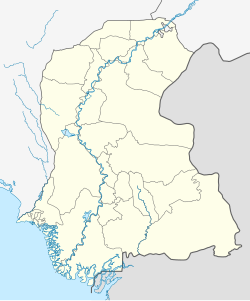| Battle of Chachro | |||||||
|---|---|---|---|---|---|---|---|
| Part of the Indo-Pakistani War of 1971 | |||||||
 10 Para (SF) team after capturing Chachro town | |||||||
| |||||||
| Belligerents | |||||||
|
|
| ||||||
| Commanders and leaders | |||||||
| Unknown | ||||||
| Units involved | |||||||
17 Grenadiers 10 Para SF |
| ||||||
| Casualties and losses | |||||||
|
Indian claim: None |
~3,000 sq miles of sandy wastes lost [3] Indian claim: 36 killed | ||||||
Location of the battle with geopolitical borders in Pakistan | |||||||
The Battle of Chachro involved a division-sized assault and multiple raids by the Indian Armed Forces on the eastern town of Chachro in the Thar desert of West Pakistan. The battle resulted in India capturing the town and around 3,000 sq. miles of surrounding sandy wasteland.[5] While a large area was captured, it had little to no economic or political impact on Pakistan owing to the region's emptiness.[6]
- ^ Gill (2003), p.58
- ^ Gill (2003), p.58
- ^ Gill (2003), p.58
- ^ Praval (2011)
- ^ Gill, John H. (2003). An Atlas of the 1971 India - Pakistan War: The Creation of Bangladesh. National Defense University, Near East South Asia Center for Strategic Studies. p. 58.
- ^ Singh, Maj Gen Sukhwant (1981). India's Wars Since Independence The Liberation Of Bangladesh. Lancer Publishers LLC. ISBN 978-1-935501-60-2. Archived from the original on 22 May 2023. Retrieved 10 July 2023.
The biggest territorial conquest in terms of territory was however in the Naya Chor and Chachro area of the Barmer sector, where two simultaneous thrusts towards Naya Chor and Umarkot had created a salient in the Sind sector of Pakistani territory. Although impressive on maps and in terms of statistics, this was a vast expanse of empty, unproductive sand. Apart from the burden of upkeep of the refugee population of the desert, its continued occupation was embarrassing to the holding troops because of lack of water and an inadequate logistic infrastructure. Much work had to be done in the way of laying a sweetwater pipeline and storage tanks, restoring the railway line to Naya Chor and constructing desert roads with coastly duckboards to maintain the troops deployed there. These facilities, created at considerable expense, had to be abandoned, almost intact, at the time of withdrawal. Militarily, conquest was a prerequisite for an advance into the productive green belt. Since the momentum of the thrust had already fizzled out on reaching its fringes possession of this territory was of no consequence. Economically, it was a drain and certainly no longer cost effective. Its loss had made no dent in Pakistan's economy, nor affected its political standing in Sind.

